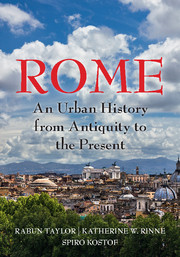Book contents
- Frontmatter
- Dedication
- Epigraph
- Contents
- List of Illustrations
- Acknowledgments
- Map
- INTRODUCTION
- 1 A BEND IN THE RIVER
- 2 A STORYBOOK BEGINNING
- 3 IDEOLOGICAL CROSSFIRE
- 4 BIG MEN ON THE CAMPUS
- 5 RES PUBLICA RESTITUTA
- 6 MEMORIALS IN MOTION: SPECTACLE IN THE CITY
- 7 THE CONCRETE STYLE
- 8 REMAKING ROME'S PUBLIC CORE: I
- 9 REMAKING ROME'S PUBLIC CORE: II
- 10 CRISIS AND CONTINUITY
- 11 RUS IN URBE: A GARDEN CITY
- 12 ADMINISTRATION, INFRASTRUCTURE, AND DISPOSAL OF THE DEAD
- 13 MAPPING, ZONING, AND SEQUESTRATION
- 14 TETRARCHIC AND CONSTANTINIAN ROME
- 15 TROPHIES AND TITULI: CHRISTIAN INFRASTRUCTURE BEFORE CONSTANTINE
- 16 WALLS MAKE CHRISTIANS: FROM FOURTH TO FIFTH CENTURY
- 17 A TALE OF TWO ROMES
- 18 THE ROME OF GOTHS AND BYZANTINES
- 19 CHRISTIAN FOUNDATIONS
- 20 FROM DOMUS LATERANI TO ROMANUM PALATIUM
- 21 THE LEONINE CITY: ST. PETER'S AND THE BORGO
- 22 VIA PAPALIS, THE CHRISTIAN DECUMANUS
- 23 THE URBAN THEATERS OF IMPERIUM AND SPQR
- 24 HOUSING DAILY LIFE
- 25 CHAOS IN THE FORTIFIED CITY
- 26 THE TIBER RIVER
- 27 HUMANIST ROME, ABSOLUTIST ROME (1420–1527)
- 28 PLANNING COUNTER REFORMATION ROME
- 29 PROCESSIONS AND POPULATIONS
- 30 MAGNIFICENT PALACES AND RHETORICAL CHURCHES
- 31 NEOCLASSICAL ROME
- 32 PICTURING ROME
- 33 REVOLUTION AND RISORGIMENTO
- 34 ITALIAN NATIONALISM AND ROMANITÀ
- 35 A CITY TURNED INSIDE OUT
- Glossary of Persons, Places, and Terms
- Works Cited
- Index
26 - THE TIBER RIVER
Published online by Cambridge University Press: 05 July 2016
- Frontmatter
- Dedication
- Epigraph
- Contents
- List of Illustrations
- Acknowledgments
- Map
- INTRODUCTION
- 1 A BEND IN THE RIVER
- 2 A STORYBOOK BEGINNING
- 3 IDEOLOGICAL CROSSFIRE
- 4 BIG MEN ON THE CAMPUS
- 5 RES PUBLICA RESTITUTA
- 6 MEMORIALS IN MOTION: SPECTACLE IN THE CITY
- 7 THE CONCRETE STYLE
- 8 REMAKING ROME'S PUBLIC CORE: I
- 9 REMAKING ROME'S PUBLIC CORE: II
- 10 CRISIS AND CONTINUITY
- 11 RUS IN URBE: A GARDEN CITY
- 12 ADMINISTRATION, INFRASTRUCTURE, AND DISPOSAL OF THE DEAD
- 13 MAPPING, ZONING, AND SEQUESTRATION
- 14 TETRARCHIC AND CONSTANTINIAN ROME
- 15 TROPHIES AND TITULI: CHRISTIAN INFRASTRUCTURE BEFORE CONSTANTINE
- 16 WALLS MAKE CHRISTIANS: FROM FOURTH TO FIFTH CENTURY
- 17 A TALE OF TWO ROMES
- 18 THE ROME OF GOTHS AND BYZANTINES
- 19 CHRISTIAN FOUNDATIONS
- 20 FROM DOMUS LATERANI TO ROMANUM PALATIUM
- 21 THE LEONINE CITY: ST. PETER'S AND THE BORGO
- 22 VIA PAPALIS, THE CHRISTIAN DECUMANUS
- 23 THE URBAN THEATERS OF IMPERIUM AND SPQR
- 24 HOUSING DAILY LIFE
- 25 CHAOS IN THE FORTIFIED CITY
- 26 THE TIBER RIVER
- 27 HUMANIST ROME, ABSOLUTIST ROME (1420–1527)
- 28 PLANNING COUNTER REFORMATION ROME
- 29 PROCESSIONS AND POPULATIONS
- 30 MAGNIFICENT PALACES AND RHETORICAL CHURCHES
- 31 NEOCLASSICAL ROME
- 32 PICTURING ROME
- 33 REVOLUTION AND RISORGIMENTO
- 34 ITALIAN NATIONALISM AND ROMANITÀ
- 35 A CITY TURNED INSIDE OUT
- Glossary of Persons, Places, and Terms
- Works Cited
- Index
Summary
TODAY IT IS HARD TO IMAGINE WHAT THE TIBER RIVER (FIG. 156) WAS LIKE in the fourteenth and fifteenth centuries when it was still the heart of Rome's small but bustling industrial zone. Brickmakers and potters worked on the right bank; tanners and candlemakers on the left; millers, stevedores, and laundresses along both sides, with ferrymen navigating between them. The acquaeroli – water merchants who sold Tiber water for drinking now that the aqueducts were essentially dry – usually claimed the upper stretches, where there was less pollution. The millers worked where the current was strongest, from the bend of the Tiber at the Hospital of Santo Spirito in the Borgo to below Pons Aemilius (called Ponte S. Maria since the early eleventh century) and especially near the Tiber Island, where they had congregated ever since Belisarius had the millwheels moved there from the Janiculum Hill after the Gothic War (Fig. 157). Polluting industries, such as tanning and ceramics, were restricted to less salubrious parts of the river. The ceramicists worked along Via dei Vascellari (Pottery Row) in Trastevere, where their kilns and smoke posed less threat to the city, and the tanners, whose work was perhaps the filthiest of all, were restricted to an area just above the Tiber Island on the left bank.
The Tiber was still congested with vessels bearing goods and people to Rome as they had for 2,000 years, and stretches of the river were still zoned for port activities. But Rome had long gone without amphoras filled with Spanish olive oil offloaded at Testaccio, or majestic blocks of Greek marble hoisted off imperial barges at the Emporium below the Aventine. Since at least the ninth century, when Saracen pirates had imperiled Ostia, Rome's few docks lay within the walls. To supplement the Leonine Walls, Pope Leo IV also built two towers near Porta Portuensis anchoring a chain suspended across the Tiber to prevent attacks from downstream.
Testaccio, now far outside the inhabited area, became both farmland and a seasonal playground for bullfights and other sports (Fig. 158; see Fig. 178), while the ancient imperial port known as Pietra Papa farther south on the right bank was now stranded 50 meters from the shore as the Tiber shifted its course.
- Type
- Chapter
- Information
- RomeAn Urban History from Antiquity to the Present, pp. 241 - 250Publisher: Cambridge University PressPrint publication year: 2016



